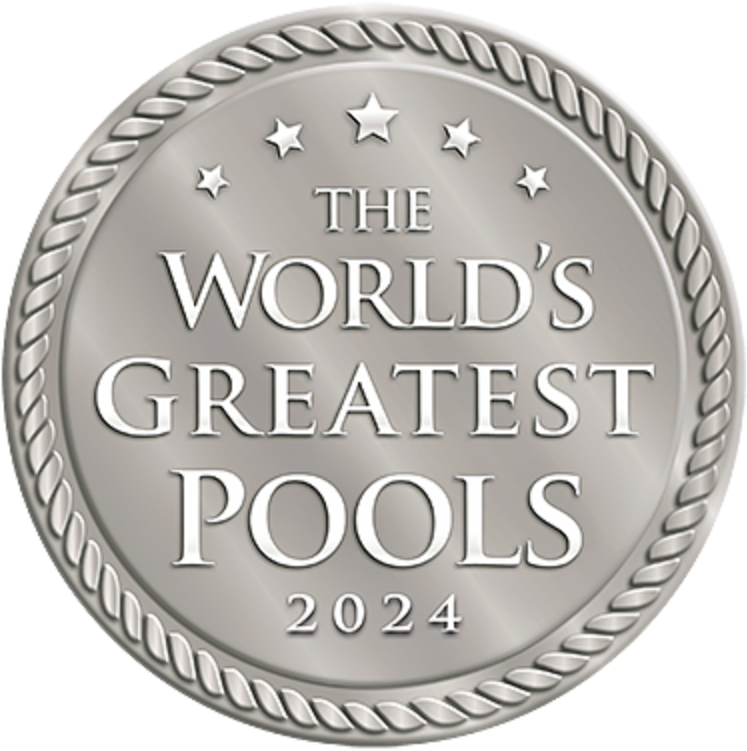The cost of a plunge pool can vary widely based on several factors. On average, you're likely looking at a range from $15,000 to $30,000. Key determinants include the size, depth, materials used, and any additional custom features you opt for. Installation and labor costs, as well as ongoing maintenance and equipment expenses, also drive up the price. Seasonal preparations, geographical location, and market trends can all influence the initial investment and upkeep. While that's a quick rundown, there's more to unpack about plunge pool prices. Stick with us for a thorough breakdown of all influencing factors and potential cost-saving tips.
Understanding Plunge Pool Costs
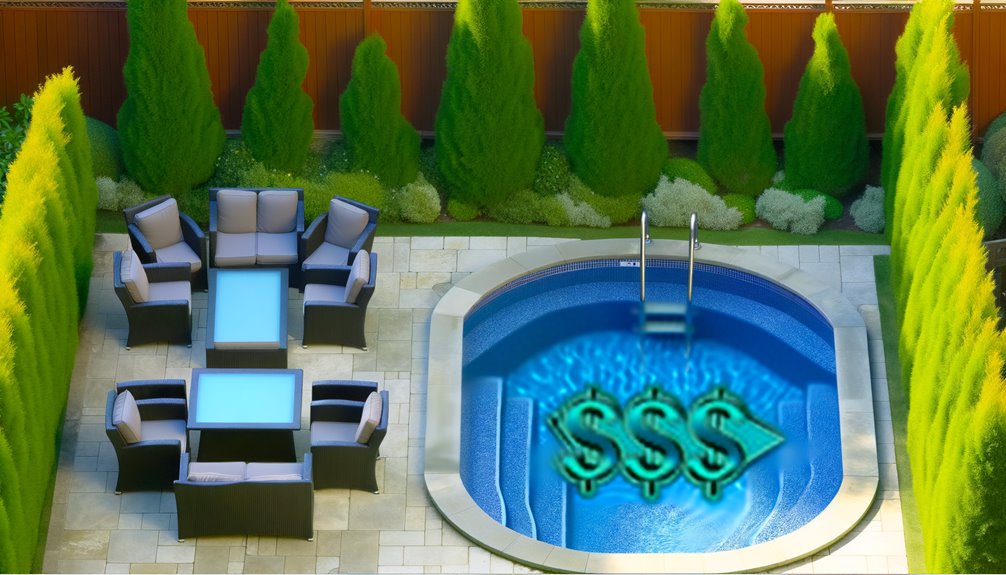
Almost every homeowner dreams of having a plunge pool, but understanding the costs involved can seem intimidating. Thankfully, you're not alone in this.
Plunge pool benefits are numerous, and they come in various designs, which can impact the cost. A basic plunge pool design, devoid of extra features like heating or lighting, can be more affordable than you might think.
However, the more features you add, the higher the cost climbs. This includes custom shapes, sizes, and finishes.
It's not just the initial cost you should consider, either. Ongoing maintenance, such as cleaning and chemical treatment, also add to the overall cost.
Size and Depth Factors
When considering the cost of a plunge pool, you'll find that size and depth play significant roles.
The dimensions you choose directly impact the final price, so it's essential to understand how each factor contributes.
Let's explore how pool depth and size can influence the overall cost of your plunge pool.
Determining Pool Dimensions
Wondering how to determine the size and depth of your plunge pool? It's not as tough as you might think.
Start by considering your pool's shape. This could be anything from a simple circle to an intricate, custom design. But remember, the more complex your pool shape, the more it may impact the final cost.
Next, ponder design considerations. How much space do you have? What's the pool's purpose? Is it for exercise, relaxation, or both?
These questions will help you decide on the best dimensions. For example, a pool meant for swimming laps will have different depth requirements compared to one designed for lounging.
Choose wisely to get the most from your plunge pool.
Cost by Pool Depth
While it's important to understand that the size and depth of your plunge pool directly influence its cost, it's also essential to take into account these factors in relation to the pool's intended usage.
A deeper plunge pool may serve your needs better if you're looking for a vigorous swim, but it'll also drive up the cost. Why? Because a greater plunge pool depth requires more materials for construction, more water to fill, and often more maintenance.
Plunge pool pricing can also be influenced by the type of material used for construction–the deeper the pool, the more material needed, consequently potentially increasing the price.
Size Influence on Price
Size plays an undeniable role in determining the cost of your plunge pool. Bigger plunge pool dimensions usually mean a higher price tag. But remember, it's not just about width and length; depth can also affect the cost. More depth means more materials and labor, which inevitably increases the price.
Consider your budget carefully. An overly large or deep pool might not be feasible if you're on a tight budget. Here's a quick comparison:
| Pool Size (ft) | Approximate Cost ($) |
|---|---|
| 10×10 | 7,500 – 10,000 |
| 12×12 | 10,000 – 15,000 |
| 14×14 | 15,000 – 20,000 |
| 16×16 | 20,000 – 25,000 |
| 18×18 | 25,000 – 30,000 |
Material Choices Impact
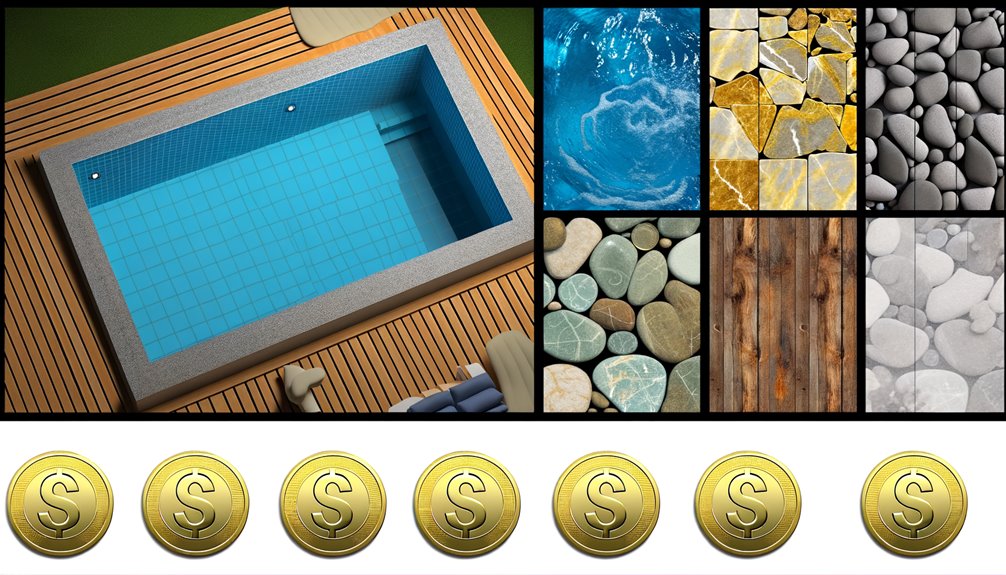
When considering the costs of a plunge pool, your choice of material can greatly impact the overall price.
Let's examine the cost implications of three common options: concrete, fiberglass, and vinyl liner pools.
Each material comes with its own pros and cons, including variations in initial outlay, maintenance expenses, and lifespan, which we'll discuss in detail.
Concrete Pools: Price Analysis
Opting for a concrete plunge pool can greatly influence the total costs associated with installation. Generally, they're pricier due to their durability and flexibility in design.
Concrete pool longevity plays a substantial role in the higher upfront costs, given they can last for decades with proper care. However, concrete pool maintenance can be more demanding. They require regular brushing to prevent algae buildup, and every 10-15 years, you'll need to invest in resurfacing.
These maintenance costs can add up over time, thereby impacting the overall price. It's crucial to evaluate these factors when choosing a concrete pool, balancing the initial investment against the long-term costs and benefits.
Fiberglass Pool Costs
While concrete pools have their advantages, you might be considering a fiberglass plunge pool, another popular option.
One of the fiberglass benefits is its lower initial cost. Typically, these pools range from $15,000 to $30,000, depending on the size and design. The installation process is generally quicker than concrete as most fiberglass pools come preformed and then placed into a previously dug hole.
You also save on maintenance costs as fiberglass is non-porous, preventing algae growth. Plus, it's smoother to touch, reducing the likelihood of scrapes and bruises.
However, keep in mind that although fiberglass pools require less upfront cost and maintenance, they may not offer the same long-term durability as concrete pools.
Vinyl Liner Pool Expenses
So, you're considering a vinyl liner for your plunge pool? It's a popular choice due to its lower upfront cost.
But, you should also factor in vinyl liner durability and vinyl maintenance costs. Compared to concrete or fiberglass, vinyl liners can be less durable. Sharp objects, pets, or even harsh chemicals can damage them, leading to leaks or needing replacement.
While they're typically cheaper to replace than other materials, this can still add to your long-term costs.
Vinyl maintenance costs are also higher due to the need for regular cleaning to prevent algae growth. Consequently, while vinyl liner pools can be economical initially, they might require more maintenance and eventual replacement, increasing your overall expenses.
Installation and Labor Costs
Although you may be excited to get your new plunge pool installed, you should be aware of the associated installation and labor costs. Different installation techniques can greatly impact the total price.
Traditional methods, which involve excavation and concrete pouring, can be more expensive. On the other hand, prefabricated plunge pools can decrease installation costs due to their simpler setup process.
Labor pricing varies based on your location and the complexity of the job. In general, expect to pay anywhere from $50 to $75 per hour for skilled labor.
Cost of Pool Equipment
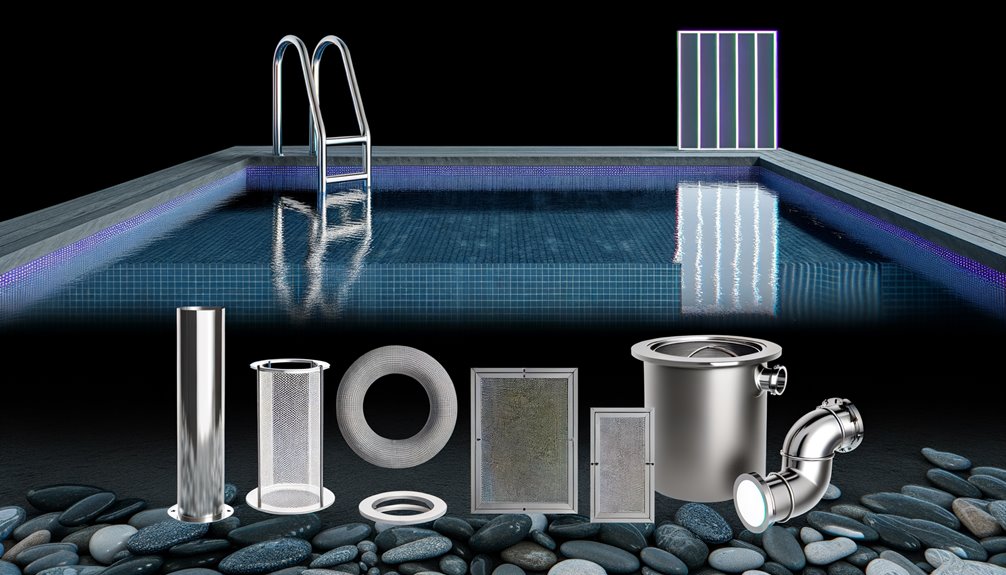
Now, let's talk about the cost of pool equipment.
From filters to heaters, there's a range of vital plunge pool equipment you'll need to take into account, and various factors can influence these costs.
However, don't worry – there are also ways you can save on this important aspect of pool ownership.
Essential Plunge Pool Equipment
While you may be focused primarily on the cost of the plunge pool itself, it's essential to not overlook the price of fundamental pool equipment. This includes items that guarantee your pool is safe, functional, and enjoyable.
Here's a breakdown of some key pieces of equipment you'll need:
- Plunge pool heaters: These maintain a comfortable water temperature and extend your pool use into the cooler months.
- Plunge pool lights: These not only provide visibility for nighttime swims but also add ambiance.
- Pool pumps: These circulate the water, keeping it clean and clear.
- Pool filters: These remove debris, preventing buildup and maintaining water quality.
Investing in quality equipment is critical to the longevity and functionality of your plunge pool.
Factors Influencing Equipment Costs
After understanding the key pieces of equipment for your plunge pool, it's also important to note that various factors can influence the cost of these items. The equipment types you choose, such as high-end heaters or energy-efficient pumps, can greatly impact your budget. Likewise, different installation techniques can either increase or decrease the total cost.
Consider the following table for a clearer understanding:
| Factor | How it Influences Cost |
|---|---|
| Equipment Types | High-end models and advanced systems often cost more, but may offer longer lifespans and better performance. |
| Installation Techniques | While DIY can save money, professional installation guarantees correct setup but comes with labor costs. |
| Market Trends | Prices can fluctuate based on supply and demand, or changes in technology. |
Being aware of these factors will aid in planning your budget effectively.
Saving on Pool Equipment
Ever wondered how you can cut back on your plunge pool equipment expenses? Investing in energy efficient options and budget-friendly equipment can make a significant difference.
Here are some strategies:
- Opt for energy efficient pumps. They might be pricier upfront, but they'll save you more in the long run.
- Choose LED lights. They're more efficient and longer-lasting than traditional bulbs.
- Consider a solar heating system. It can drastically reduce your heating costs.
- Look for second-hand equipment. Just make sure it's in good condition.
Climate and Location Considerations
Before you immerse yourself in the installation of a plunge pool, it's essential to take into account your local climate and the specific location of your property.
The climate impact on your pool can't be underestimated. If you live in a colder area, for instance, you might need to invest in a pool heater, which will add to the overall cost. Conversely, in a hot climate, a shaded area or pool cover may be necessary to prevent water evaporation.
The location influence on your pool is equally significant. The accessibility of your property, its slope, and soil type can all affect the installation process and cost.
It's imperative that you carefully consider these factors to accurately estimate your plunge pool expenses.
Ongoing Maintenance Expenses
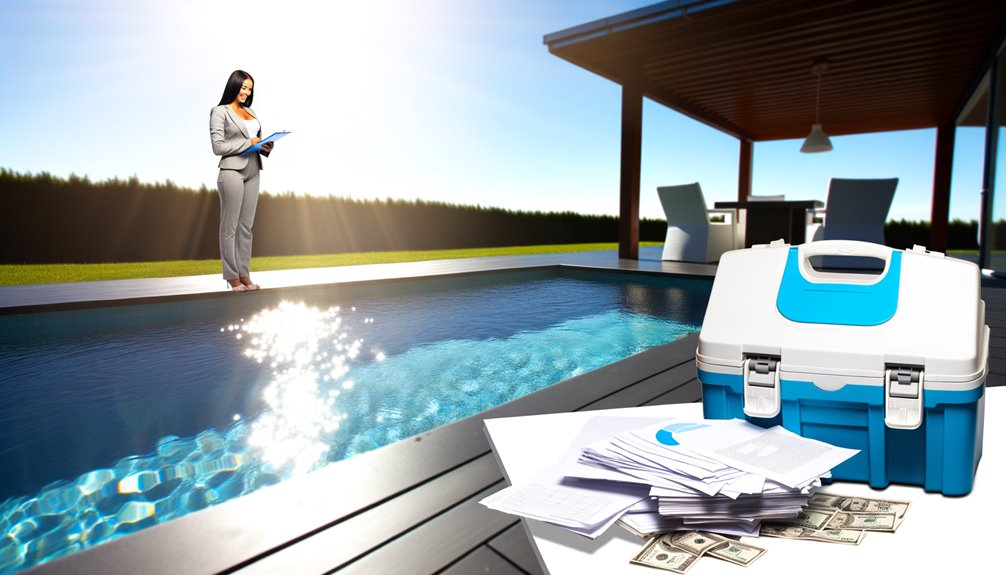
While the initial cost of your plunge pool is important, you shouldn't overlook the ongoing maintenance expenses. These include a variety of tasks, essential to uphold the quality, safety, and longevity of your pool.
- Water Chemistry: Regular testing and adjusting of chemical levels is critical to maintain a healthy and clean pool environment.
- Cleaning Techniques: Proper and regular cleaning, including skimming, vacuuming, and brushing, prevents algae buildup and keeps your pool looking its best.
- Equipment Maintenance: Pumps, heaters, and filters require periodic servicing or replacement.
- Professional Services: If you're not up for DIY maintenance, contracting a pool service company is an option, but it comes with a price.
Custom Features and Their Costs
Beyond the basic structure and upkeep of your plunge pool, custom features can greatly influence the total costs. These elements, often termed luxury additions, can give your pool a unique touch, showcasing your style and enhancing your swimming experience. However, they come with their own price tag.
Consider some popular custom features and their approximate costs:
| Custom Feature | Approximate Cost |
|---|---|
| Waterfalls | $1,000 – $7,000 |
| LED Lighting | $450 – $1,900 |
| Heating Systems | $1,400 – $4,500 |
| Saltwater Systems | $500 – $2,500 |
| Automatic Covers | $1,000 – $3,000 |
Financing a Plunge Pool
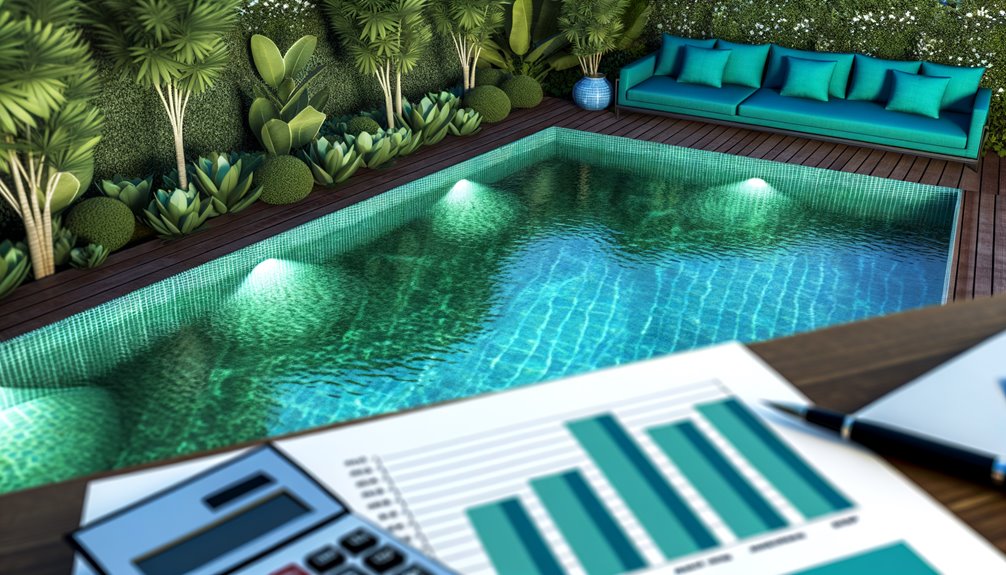
Wondering how to fund your plunge pool project? Don't fret, there are various financing options to evaluate, each with their own benefits and drawbacks.
To help you make an informed decision, here's a look at four common loan types:
- Personal Loans: Often unsecured, these loans are based on your creditworthiness and can be used for any purpose, including pool financing.
- Home Equity Loans: This type of loan uses your home as collateral. It's a good option if you've built up equity in your home.
- Home Improvement Loans: These loans are specifically intended for home improvements.
- Credit Cards: If you have a high credit limit, this can be a quick but expensive option.
Cost Saving Tips for Plunge Pools
Even though the thought of installing a plunge pool may seem extravagant, there are various cost-saving strategies you can employ to manage your budget effectively.
One such strategy is DIY installation. While it's not for everyone, if you're handy and up for the challenge, it can save you a significant amount.
Regarding energy efficiency, opt for a pool with a cover to reduce heat loss and water evaporation.
Your budget planning should also account for ongoing costs like maintenance and water conservation measures. Install water-saving devices, such as a rainwater tank to fill your pool, which can reduce your water bills.
Frequently Asked Questions
What Are the Health Benefits of Owning a Plunge Pool?
Imagine stepping into your own plunge pool.
It's more than just about luxury, it's about health too.
With a plunge pool, you're not merely cooling off on hot days, you're also reaping significant health benefits.
The cold water can help improve circulation, soothe sore muscles, and even boost your mood.
It's a revitalizing, invigorating experience that's good for your body and your mind.
How Long Does It Take to Install a Plunge Pool?
You're curious about the installation timeline for a plunge pool, aren't you?
Well, the process isn't too lengthy. Typically, it takes between 1 to 3 weeks, depending on the complexity of the project. This includes excavation, installation, and finishing touches.
Do Plunge Pools Increase Home Value?
Yes, plunge pools often increase home value.
Just like a cherry on top of a sundae, they're the finishing touch that makes your house irresistible.
The benefits of a plunge pool extend beyond mere aesthetics. They're also great for relaxation and boosting your physical health.
Potential buyers will see these benefits and be willing to pay more.
However, the increase in home resale value largely depends on your real estate market's preferences.
What Safety Measures Should Be Considered for Plunge Pools?
When considering safety measures for plunge pools, you'll definitely want to think about safety barriers and water depth.
It's essential to install fences or alarms to prevent unsupervised access, particularly for kids.
Mind the water depth too; it shouldn't be too deep for comfort or safety.
Always remember, safety measures are an integral aspect of owning a plunge pool.
It isn't just about having a revitalizing dip, but ensuring everyone's well-being.
Can Plunge Pools Be Heated or Cooled?
Absolutely, you can heat or cool your plunge pool. Various heating options are available, like solar, electric, and gas heaters.
They'll allow you to enjoy a warm soak even in cold weather. On the other hand, cooling systems are also available if you're in a hot climate and want a revitalizing dip.
